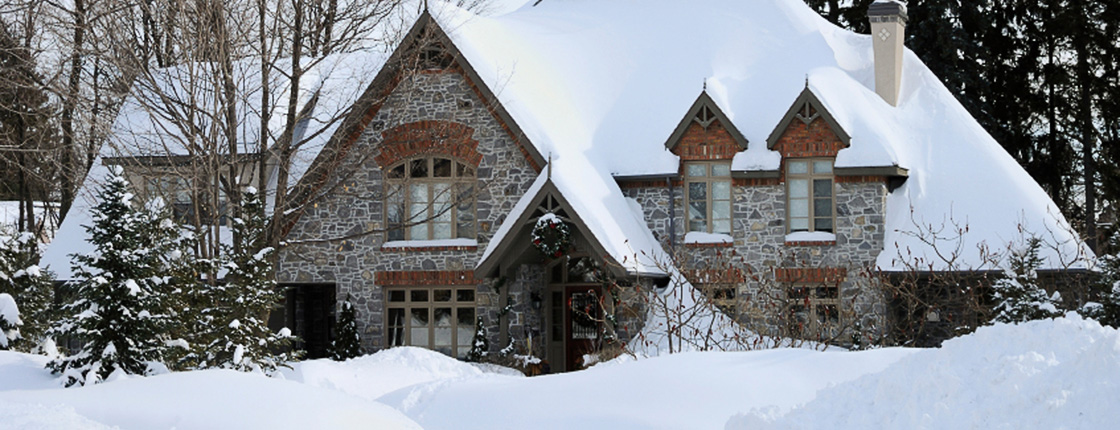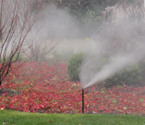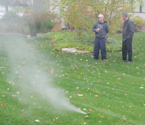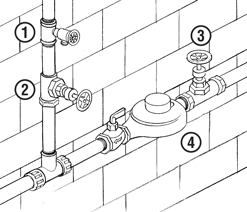
Every year, before the first freeze, the ritual of irrigation "blow out" becomes the priority for all irrigation systems that are in regions of the country where the frost level extends below the depth of the installed piping.
Due to the potential dangers involved with winterization,
it is best to call a professional.

Even if you have drained some water out of the system, the remaining water can freeze, expand and crack the PVC piping (rigid, white pipe), usually from fitting to fitting. Polyethylene pipe (flexible, black pipe) is used in many freezing climates. Although polyethylene pipe is more flexible and can expand under pressure, water left inside could freeze and rupture the pipe walls. Freezing water in the backflow assembly will damage the internal components and could possibly crack the brass body.
To minimize the risk of freeze damage to your irrigation system, you'll need to "winterize" your irrigation system. Irrigation systems in areas where "winterization" is mandatory are installed using one of three types of water removal in mind: manual drain, auto drain, or blowout. If you don't know your system type, it would be best to use the blowout method.
Manual Drain Method
Use when manual valves are located at the end and low points of the irrigation piping. To drain these systems, simply shut off the irrigation water supply (shut off will be located in the basement and will be either a gate/globe valve, ball valve or stop and waste valve - see drawings below) and open all the manual drain valves. Once the water has drained out of the mainline, open the boiler drain valve or the drain cap on the stop and waste valve (whichever is used in your area) and drain all the remaining water that is between the irrigation water shut off valve and the backflow device. Open the test cocks on the backflow device. If your sprinklers have check valves you'll need to pull up on the sprinklers to allow the water to drain out the bottom of the sprinkler body. Depending on the location of the drain valves, there could be some water left in the backflow, the piping and the sprinklers. When all the water has drained out, close all the manual drain valves.
Automatic Drain Method
Use when automatic drain valves are located at the end and low points of the irrigation piping. These will automatically open and drain water if the pressure in the piping is less than 10 PSI. To activate these, you shut off the irrigation water supply (shut off will be located in the basement and will be either a gate/globe valve, ball valve or stop and waste valve - see drawings below) and activate a station to relieve the system pressure. Once the water has drained out of the mainline, open the boiler drain valve or the drain cap on the stop and waste valve (whichever is used in your area) and drain the remaining water that is between the irrigation water shut off valve and the backflow device. Open the test cocks on the backflow device. If your sprinklers have check valves you'll need to pull up on the sprinklers to allow the water to drain out the bottom of the sprinkler body. Depending on the location of the drain valves, there could be some water left in the backflow, the piping and in the sprinklers.
In some areas you might have a combination of the manual drain system on the mainline (the pipe between the irrigation water shut off valve and the valves) and auto drain system on the lateral lines (the pipe between the valves and the sprinklers).
"Blow Out" Method

Blow out on a spray

Blow out on a rotor
WARNING! Wear ANSI-approved safety eye protection! Extreme care must always be taken when blowing out the system with compressed air. Compressed air can cause serious injury, including serious eye injury, from flying debris. Always wear ANSI approved safety eye protection and do not stand over any irrigation components (pipes, sprinklers and valves) during air blow out. Serious personal injury may result if you do not proceed as recommended! It is recommended that a qualified licensed contractor perform this type of "Winterization" method. The blow out method utilizes an air compressor with a Cubic Foot per Minute (CFM) rating of 80-100 for any mainline of 2" or less. These types of compressors can be rented at your local equipment rental yard. The compressor is attached to the mainline via a quick coupler, hose bib or other type connection, which is located after the backflow device. Compressed air should not be blown through any backflow device. To start the "blow out", shut off the irrigation water supply and, with the compressor valve in the closed position, attach the air compressor hose to the fitting. Activate the station on the controller that is the zone or sprinklers highest in elevation and the furthest from the compressor. Close the backflow isolation valves. Then slowly open the valve on the compressor; this should gradually introduce air into the irrigation system. The blow out pressure should remain below the maximum operating pressure specification of the lowest pressure rated component on that zone and should NEVER exceed 80 PSI.
Each station/zone should be activated starting from the furthest station/zone from the compressor slowly working your way to the closest station/zone to the compressor. Each station/zone should be activated until no water can be seen exiting the heads, this should take approximately two minutes or more per station/zone. It is better to use two or three short cycles per station/zone than to have one long cycle. Once the station/zone is dry, you should not continue to blow air through the pipe. Compressed air moving through dry pipes can cause friction, which will create heat and the heat could cause damage.
Additional Steps
Once the water has been removed from the irrigation system, disconnect the air compressor and release any air pressure that may be present. If your backflow device, the most common backflow installed is called a Pressure Vacuum Breaker, has ball valves, open and close the isolation valves on the backflow device numerous times to ensure that any trapped water has escaped from the upper areas. Leave the isolation valves open at a 45° angle (approximately 1/2 open) and open the test cocks.
-
Pressure Vacuum Breaker

- PVB Test Cocks
- Isolation Ball Valve Inlet
- Isolation Ball Valve Outlet
-
Interior Point of Connection Freezing Climates

- Boiler Valve
- Irrigation Shut Off Valve
- Main Water Shut Off Valve
- Water Meter
Types of Valves
-

Gate Valve
-

Ball Valve
-

Stop and Waste Valve
-

Boiler Valve
Preparing a hydraulic control system?
Shut off the water supply to the signal control tube(s) and drain the field tubing.
Outdoor mounted controllers?
Leave the power on and the dial / switch in the "Off" position. The heat from the transformer will keep the enclosure warm enough to keep condensation from forming inside the controller enclosure. The dial in the "OFF" will keep the controller from activating the solenoids in the field.
Indoor mounted controllers?
You may either leave the power on and the dial/switch in the "Off" position OR you may remove the battery backup and unplug the transformer.
Rain Sensors?
There is not much to do to prepare the rain sensor for the winter months. If your sensor is the type with a cup or bowl that catches water, you might want to remove the water and place a plastic bag over the sensor. This will keep any water from accumulating and freezing in the cup or bowl area. If your sensor is the type that uses wafers or discs, you might want to remove the wafers and store them in the garage for the winter months. This will keep damp wafers from freezing.
The Do NOTS of "BLOW~OUT" Winterization
WARNING! WEAR ANSI APPROVED SAFETY EYE PROTECTION! Extreme care must always be taken when blowing out the system with compressed air. Compressed air can cause serious injury, including serious eye injury, from flying debris. Always wear ANSI approved safety eye protection and do not stand over any irrigation components (pipes, sprinklers and valves) during air blow out. SERIOUS PERSONAL INJURY MAY RESULT IF YOU DO NOT PROCEED AS RECOMMENDED!
- Do not allow the air pressure to exceed 80 PSI for systems with PVC piping and 50 PSI for systems with polyethylene piping.
- Do not stand over component parts while the system is pressurized with air.
- Do not leave the air compressor unattended.
- Do not blow the system out through a backflow or pump. First blow out the system, then drain the backflow or pump.
- Do not leave the manual drain valves open after the blow out.

